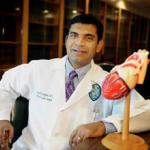Dr. Anand Irimpen
Professor of Medicine

Biography
Anand M. Irimpen, MD joined the Tulane University Heart and Vascular Institute in 1992 as a General Cardiology Fellow before becoming an Interventional Cardiology Fellow. He currently is an Associate Professor of Medicine and Director of our Interventional Cardiology Fellowship. He is a graduate of the Grant Medical College at Bombay University, Byculla in Bombay, India and received further professional medical training through an internship in the Department of Medicine at St. Luke’s Hospital at Case Western Reserve University in Cleveland Ohio and a residency in the Department of Medicine at the Medical College of Ohio at Toledo. In addition to his clinical work, Dr. Irimpen does research, most recently a study on the effects of Hurricane Katrina on acute myocardial infarction in New Orleanians impacted by the storm. This scholarly project won first place at this year’s American College of Cardiology conference for the state of Louisiana.
Links
Articles
The broken heart syndrome: Takotsubo cardiomyopathy
First described in 1990, Takotsubo cardiomyopathy consists of a transient systolic dysfunction of localized segments of the left ventricle. Commonly occurring in postmenopausal women, Takotsubo is often associated with intense physical and/or emotional stress. It is traditionally identified by distinctive wall motion patterns on transthoracic echocardiogram and left ventriculography. Further understanding of the disease mechanisms and recognition of at-risk populations has potentially tremendous therapeutic benefit.
OxLDL induces endothelial dysfunction and death via TRAF3IP2: Inhibition by HDL3 and AMPK activators
2014
Oxidized low-density lipoprotein (oxLDL) induces endothelial cell death through the activation of NF-κB and AP-1 pathways. TRAF3IP2 is a redox-sensitive cytoplasmic adapter protein and an upstream regulator of IKK/NF-κB and JNK/AP-1. Here we show that oxLDL-induced death in human primary coronary artery endothelial cells (ECs) was markedly attenuated by the knockdown of TRAF3IP2 or the lectin-like oxLDL receptor 1 (LOX-1). Further, oxLDL induced Nox2/superoxide-dependent TRAF3IP2 expression, IKK/p65 and JNK/c-Jun activation, and LOX-1 upregulation, suggesting a reinforcing mechanism. Similarly, the lysolipids present in oxLDL (16:0-LPC and 18:0-LPC) and minimally modified LDL also upregulated TRAF3IP2 expression. Notably, whereas native HDL3 reversed oxLDL-induced TRAF3IP2 expression and cell death, 15-lipoxygenase-modified HDL3 potentiated its proapoptotic effects. The activators of the AMPK/Akt pathway, adiponectin, AICAR, and metformin, attenuated superoxide generation, TRAF3IP2 expression, and oxLDL/TRAF3IP2-mediated EC death. Further, both HDL3 and adiponectin reversed oxLDL/TRAF3IP2-dependent monocyte adhesion to endothelial cells in vitro. Importantly, TRAF3IP2 gene deletion and the AMPK activators reversed oxLDL-induced impaired vasorelaxation ex vivo. These results indicate that oxLDL-induced endothelial cell death and dysfunction are mediated via TRAF3IP2 and that native HDL3 and the AMPK activators inhibit this response. Targeting TRAF3IP2 could potentially inhibit progression of atherosclerotic vascular diseases.
Natural Disasters and Myocardial Infarction: The Six Years After Hurricane Katrina
2014
To determine the prolonged effect of Hurricane Katrina on the incidence and timing of acute myocardial infarction (AMI) in the city of New Orleans.
Effect of Hurricane Katrina on Chronobiology at Onset of Acute Myocardial Infarction During the Subsequent Three Years
2013
The onset of acute myocardial infarction (AMI) has been shown to occur in a nonrandom pattern, with peaks in midmorning and on weekdays (especially Monday). The incidence of AMI has been shown to increase locally after natural disasters, but the effect of catastrophic events on AMI biorhythms is largely unknown. To assess the differences in the chronobiology of AMI in residents of New Orleans before and after Hurricane Katrina, the onset of AMI in patients at Tulane University Health Sciences Center in the 6 years before and the 3 years after Hurricane Katrina was retrospectively examined. Compared to the pre-Katrina group, the post-Katrina cohort demonstrated significant decreases in the onset of AMI during mornings (p = 0.002), Mondays (p
Primary Streptococcus Pneumoniae Pericarditis
2013
Although commonly fatal, bacterial pericarditis is often not diagnosed antemortem due to its infrequent occurrence and fulminant course. Historically, Streptococcus pneumoniae has been the most common cause of bacterial pericarditis. Over the past 70 years, however, it has become largely eliminated and now occurs almost exclusively in immunocompromised individuals with a preceding primary site of infection. Herein, we present a case of primary S. pneumoniae pericarditis that developed over the course of 3 to 4 weeks in an immunocompetent 45-year-old man. The patient, who developed cardiac tamponade shortly after admission, experienced a rapid resolution of symptoms following pericardial drainage and initiation of antibiotics.
Media Appearances
Hurricane checklist: Batteries, bottled water – and a plan for heart care
Helping with stress and anxiety is critical to help prevent some people from resorting to old bad habits – like smoking or excessive drinking, said Dr. Anand Irimpen, chief of cardiology at Southeast Louisiana Veterans Health Care System in New Orleans.
Bryan Batt and other Tulane Summer Lyric Theatre alums return for 50th anniversary show
Of course, the crowd loved every minute of it, including Mark and Barbara Workman (who has spearheaded the endowment), Paulette and Frank Stewart, Don-Paul Landry, Eddie Bonin and Rene Fransen, David Hoover and Scott Hutcheson, Debbie and Jamie Reily, Drs. Maya and Anand Irimpen, Donna Kay Berger, Michael Brown and Linda Green, Lisa Carey, Jane Haas, Jane Schuluter, Beth Utterback, Dominic Massa, Barbara and Biff Motley, Jan and Bob Carr, Cassie Worley, Walda and Sydney Besthoff, and theater founder Francis Monachino's children Dr. Vivienne Monachino Hayne and Francesca Monachino.
Hurricane Katrina linked to a rise in heart attacks years later
New Orleans cardiologist Dr. Anand Irimpen began to notice that his on-call nights at the hospital were getting busier soon after the devastation wrought by Hurricane Katrina. It seemed as if many more people were having heart attacks.
Development and Validation of a Prediction Rule for Benefit and Harm of Dual Antiplatelet Therapy Beyond 1 Year After Percutaneous Coronary Intervention
Importance Dual antiplatelet therapy after percutaneous coronary intervention (PCI) reduces ischemia but increases bleeding.
Hurricane Katrina Aftermath: Higher Heart Attack Risk for New Orleans Residents
"Overwhelmingly, the main differences in the pre- and post-Katrina populations involve psychosocial risk factors as opposed to shifts in traditional cardiovascular risk factors like hypertension, obesity and diabetes," said Dr. Anand Irimpen, the study's senior investigator at the Tulane University School of Medicine, in a statement.



